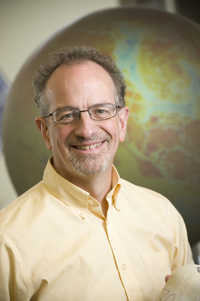 At our Wednesday, June 3, ZOOM meeting, Scott Denning (CSU Monfort Professor of Atmospheric Science) told us about his wonderful experience teaching during the most recent pandemic-shortened voyage of Semester at Sea. Semester at Sea occurs once in the Spring semester, once in the Fall semester and Scott was on the 128th voyage. Semester at Sea, which started in 1963, has been hosted at CSU since 2016.
At our Wednesday, June 3, ZOOM meeting, Scott Denning (CSU Monfort Professor of Atmospheric Science) told us about his wonderful experience teaching during the most recent pandemic-shortened voyage of Semester at Sea. Semester at Sea occurs once in the Spring semester, once in the Fall semester and Scott was on the 128th voyage. Semester at Sea, which started in 1963, has been hosted at CSU since 2016. Semester at Sea occurs on a small German cruise ship (only some 800 people on board including 61 faculty, 557 students, and 43 “Lifelong Learners”) that works as a conventional cruise ship between Semesters at Sea. The student body: 80% females (a typical distribution); average GPA of 3.4; represented 194 universities. The ship, traveling at 10 – 15 miles per hour, takes three weeks to cross the Pacific. It is sufficiently small that it reacts to waves so that Scott got “land sick” when he hit the beach in Hawaii after a number of days at sea.
Curriculum included a broad range of disciplines, although scientific topics were limited. Classroom time was only while the ship was on the move; all the time in port was devoted to exploration of the local culture. Scott taught Oceanography (with approximately 30 students) and participated in team-teaching “Global Studies”, required of all 557 students (in two groups of 300). Global Studies was taught in the main auditorium in the bow of the boat so the rolling and pitching of the boat was enhanced. Since, for the most part, there was no phone service and no internet, the students were almost all very serious and there was little absenteeism.
The cruise was originally scheduled to last four months, departing from San Diego, CA, with stops in Hawaii, Japan, China, Malaysia, India, Mauritius, South Africa, Ghana, Morocco, and ending in the Netherlands. It departed January 1 from San Diego, picking up the students at Ensenada (on the NW Baja California coast – due to US shipping rules), then proceeded to Hawaii where time spent re-fueling allowed a brief land excursion to experience some snorkeling and near-shore oceanography. The route from San Diego to Hawaii and from Hawaii to Japan was such that there were no other ships or planes anywhere. Several days docked at Kobe, Japan, allowed visits to Kyoto (the Golden Temple), Nara, and Koya-San (a monastery on top of a mountain with a 1200-year-old cemetery, the largest in Japan).
Then the effects of Coronavirus began to be felt. They had to skip the visit to China, going straight to Vietnam. The most exciting part of Ho Chi Minh City (Saigon), other than heat and humidity, was crossing the street (move slowly and deliberately). Four days on the Mekong Delta/River included experiencing the local culture by bike and small boat (read canoe) and cultivation of rice. An air excursion to Hanoi allowed them to see Halong Bay (amazing tall, thin hills surrounded by water) in a somewhat cooler climate. Re-boarding the ship required a health screening, even though there was little coronavirus present in Vietnam at that time.
With coronavirus restrictions, the cruise had to skip Malaysia and India and was not allowed to enter the Seychelles, so the next stop was Mauritius in the Indian Ocean just east of Madagascar. The island nation is populated mostly by descendants of French slaves and is the wealthiest country in Africa. There was sufficient time in Mauritius for snorkeling on the reefs and collection of samples to be examined as part of the Oceanography course.
With coronavirus restrictions on travel being instituted world-wide, the cruise was terminated with relatively short notice in Cape Town, South Africa, the next stop. From there, all of the participants were pretty well on their own to get back home, although students with financial needs were apparently helped. Scott and his wife finally arranged flights from Cape Town through Dubai and, over the North Pole, through Seattle to Denver.
Learnings from the trip: it was a great experience, but don’t go during a global pandemic. The students universally thought of it as a life-changing experience, especially showing the inter-connectedness of world society.
The ship had some facilities for exercise but they were almost always busy. The easiest was walking around the deck of the ship. For health care, there was a full-time physician and physician’s assistant as well as several nurses. The food on board was good, but this was not vacation-cruise fare, so there was little weight gain – in fact, Scott and his wife lost weight.
If you are interested in more information about Semester at Sea: http://SemesterAtSea.org
There are great opportunities for students including scholarships & financial aid; they are always looking for faculty & staff (modest salary but all expenses included); and it is a wonderful voyage for lifelong learners.